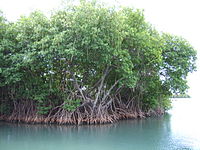
Photo from wikipedia
Lake water levels can be managed in shallow lakes in order to improve water quality and promote aquatic vegetation that presumably benefits waterbirds. We aimed to understand whether waterbird abundance… Click to show full abstract
Lake water levels can be managed in shallow lakes in order to improve water quality and promote aquatic vegetation that presumably benefits waterbirds. We aimed to understand whether waterbird abundance and species richness during fall migrations were positively influenced by managed lake water levels at 32 shallow lakes over 10 years. We conducted annual waterbird surveys that counted 6 million birds and repeatedly measured several in-lake habitat variables. Lakes with water level management had lower water depths, greater water quality and clarity, more submerged aquatic vegetation (SAV), and more wild rice (Zizania palustris L.) compared to unmanaged lakes. Redundancy analysis and regressions revealed that the waterbird community and several waterbird species were positively correlated to water level management and SAV; however, waterbirds were apparently responding principally to abundant SAV regardless of water depth or management. Two presented case studies of turbid-state lakes also highlighted that water level management rehabilitated lake habitat and waterbird use for a few years. We concluded that water level management can be an effective tool for increasing SAV and migrating waterbirds, but noted that large bird communities can also occur on unmanaged, deeper wetlands with existing SAV coverage of > 80%.
Journal Title: Hydrobiologia
Year Published: 2020
Link to full text (if available)
Share on Social Media: Sign Up to like & get
recommendations!